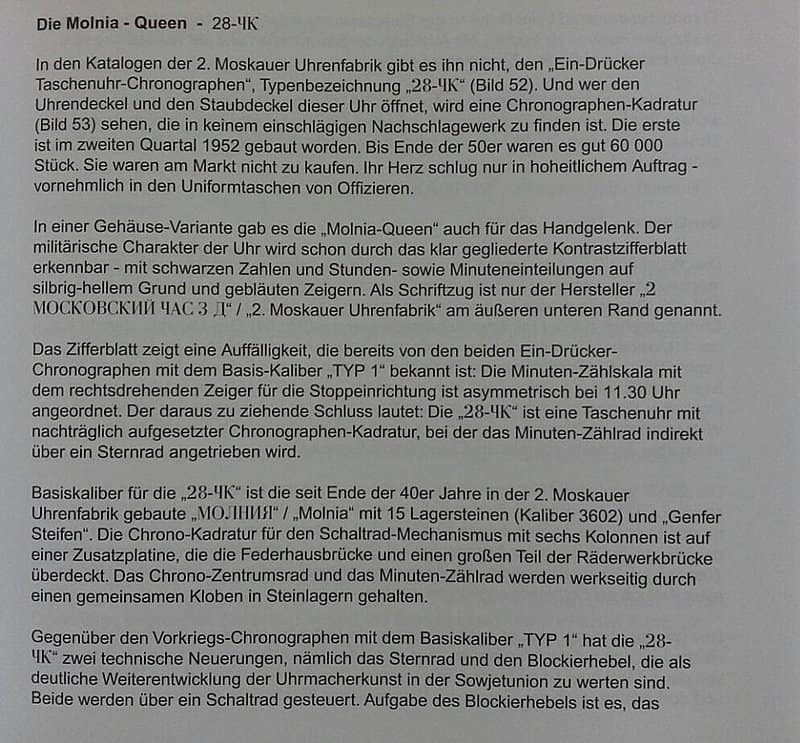@thepocketwatchman
Today, I would like to discuss what could be cataloged as the first hand-held chronograph manufactured in the Soviet Union after WWII, the renown Chk-28.

Unfortunately, there is limited information about our protagonist, but we shall certainly try to review what is known about its history.
The Chk-28 was developed by the Second Moscow Watch Factory (2MWF), based on the Molnia or Salut pocket watch, for use by the Soviet Navy. According to available chronologies, the Chk-28 was manufactured between 1952 and 1959, with about 60,000 units made in total.

The first reference that I encountered for the model is from a 1957 domestic market catalogue.

In the book by Johannes Altmeppen, a true connoisseur of marine chronos and also of Soviet watches, we find the following information:


He cites the short run of the watch (60,000 units), its military character and describes it as based on the Molnija 3062 calibre. I happen to disagree with the author about the caliber 3062 being the basis for this chronograph, since it was not manufactured at the 2MWF.
There are older examples of Molnija and Iskra movements, but these were better constructed, thiner and had a very different balance wheel bridge. The base for the caliber, in my view, was the (Chk-6), an acronym basically meaning a pocket watch with a second hand at 6 o’clock. The 3062 caliber was coarser in terms of finishings and specifications. In the catalogue we mentioned above, we can identify the subtle differences between these movements.
The inspiration for the ChK-6 It is well known, although it is less clear how the Soviets actually developed it. There are claims that Lavrentiy Beria (Stalin’s right-hand man, although he later fell out of favour) ordered that a direct copy be made of a Rolex pocket watch that came into his hands, after comparing the quality of the caliber in the Rolex with the Soviet Type 1. The Rolex caliber in question originates from the Cortebert 620, made for Rolex as well as Longines and other brands. Rolex, in turn, manufactured this caliber for Panerai. Cortebert, eventually, evolved into Unitas.
Did the Soviets copy or buy the patent from Cortebert? As always, when referring to the Soviets, the historiography generally suggests that they merely copied it, even though in many of our posts we have shown that the Soviets often sought collaboration with Western manufacturers, or purchased patents for calibers and manufacturing technology.
Below, we can see my watch, dated 1-57.

It incorporates the manufacture caliber ChK-28, dated to the first quarter of 1957, with a column wheel and 19 jewels. The most important bridges are decorated with Côtes de Genève, while the base plate is decorated with a delicate pearl. The logo of the 2MWF is stamped on one of the bridges. These elements alone indicate that this is a delicately, and well, made piece, which is hardly surprising given its origin. The case is made of stainless steel and it includes an inner movement cover made of the same material, as well as a hinged case back.

I would not want to finish this post without sharing with you a curious variant of the Chk-28. By curious, I mean a version that is very unlikely to be factory made. It is most likely a marriage watch conversion piece, albeit one that I think has been built tastefully and with very high quality finishing. This model does not appear in any catalogue and, as usual, the watch markings do not match anything in the accompanying passports, indicating this is not a real factory-produced watch, although a lot of controversy tends to surround these types of pieces.


Después de leer este artículo tengo muchas ganas de recibir mi crono Slava
Aprovecho para agradecer a Miquel su ayuda en dicha compra.
Muy bueno, como siempre nos has acostumbrado.
Muchas gracias Luis y bienvenido amigo.